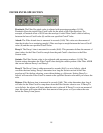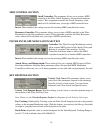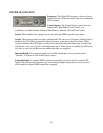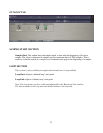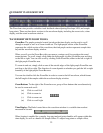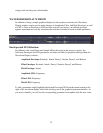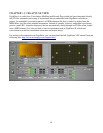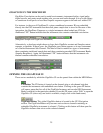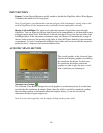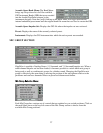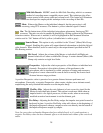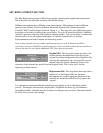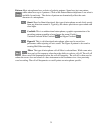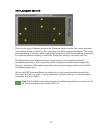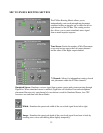
28
if the soundw
Mute: Silences the Master or the individual channels, but the processing is still
On: The On button turns off the individual microphone placements, freeing up CPU
ent
Select
Sum to Mono: This option is only available for the “Center” (Mono) Mic Group
right channe
Mic Level: Adjusts the volume of the Master or individual Left/Right mic
Mic
Perspective: Adjusts the relative perspective of the Master or individual mic
ance.
positive Perspective value is perceived as a greater distance between performer and
ound,
Wet/Dry Mix: Adjusts the ratio (balance) of wet versus dry signal for the
Pre-Delay: Adjusting the Pre-Delay nudges the impulse start point forward or
ote: In cases where an Impulse Response has been edited directly to it’s peak transient, a
ed
Mid-Side Decode: MSDEC stands for Mid-Side Decoding, which is a common
method of recording mono-compatible stereo sound. This technique also offers
custom control of the stereo width and volume levels. This button will illuminate
are developer has employed this technique in the recording of their IRs.
occurring, using CPU resources. The button is yellow when the signal is muted.
resources. The mics can also be enabled & disabled by clicking on them in the Placem
ion window. When a mic is enabled, it will be highlighted in the Placement Selection
window and its “On” button will be lit yellow (a disabled mic is unlit or gray).
channel. Enabling this option will output identical information on both the left and
ls. When disabled, audio is routed only to the output channel specified in the FX
Bus Routing section.
channel relative to all other available Mic Groups. A center channel (Mono)
Group only contains a single level fader.
channels. Perspective is the relative distance of the performer to the
microphone, and is simulated by subtle variations of timing and reson
Perspective is most often used in rooms & halls to modify the front to back
distance between stage positions.
A
microphone. Conversely, a negative Perspective value creates a tighter, more intimate s
emphasizing the early transient information over the impulse decay.
Master or individual mic channel. This option is used most often when an
impulse bank is of a digital processor; in other words, when an accurately
modeled acoustical environment is not the ultimate goal.
backward in time. A positive Pre-Delay value adds silence to the beginning of
the Impulse Response whereas a negative value cuts directly into the attack of
the Impulse Response sample by sample.
N
negative Pre-Delay value can have dramatic effects on the timbre and volume of the convolv
audio.



